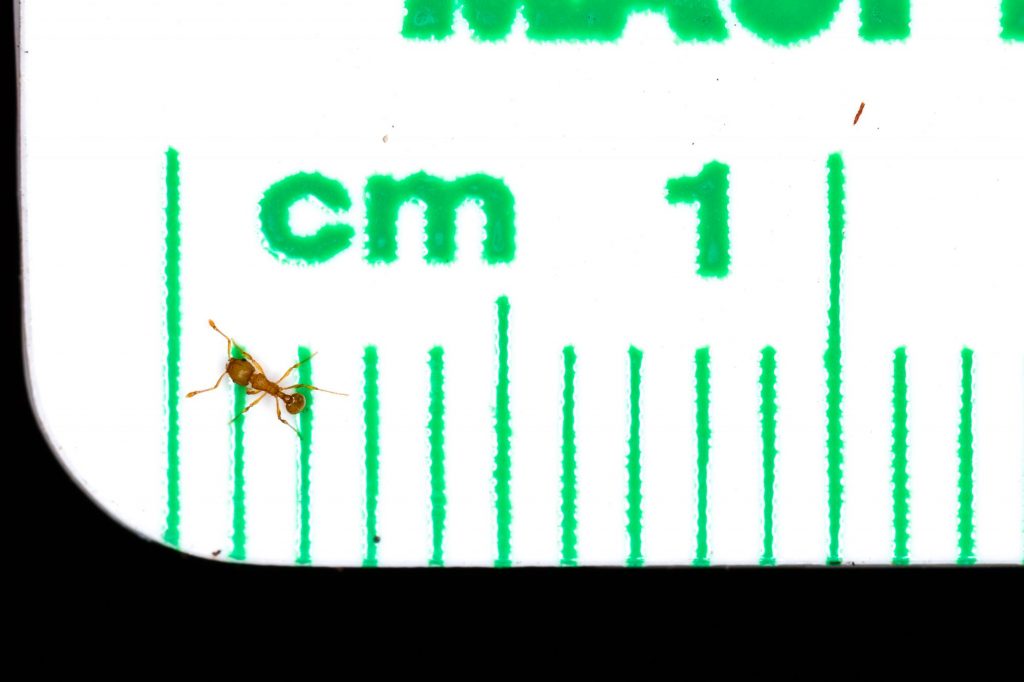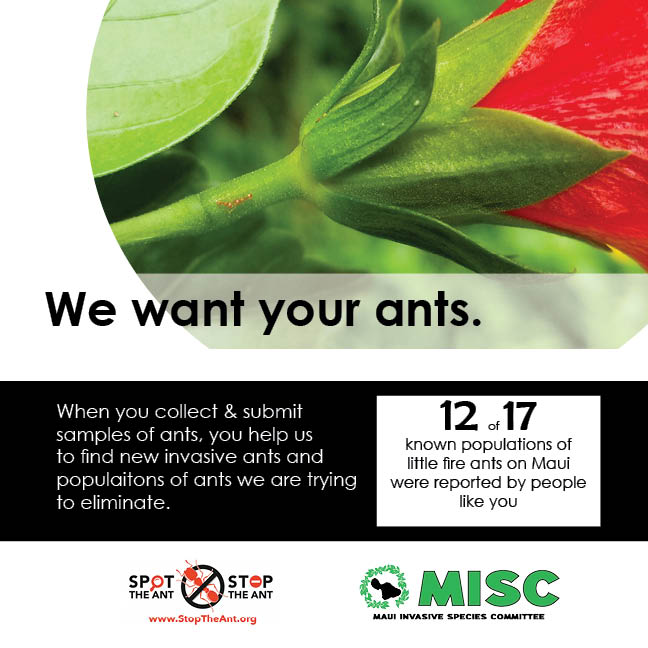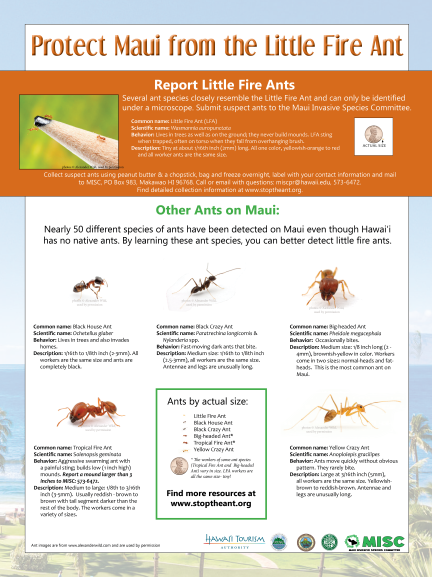
The trap-jaw ant had never before been found in Hawaiʻi until a taro farmer in Hanalei collected it. Photo credit: Tom Murray, iNaturalist.org 
Collecting ant samples can help find species new to the islands as well as stop invasive ants. Photo courtesy of Masako Cordray.
In 2017, a taro farmer in Hanalei on Kaua’i found a strange ant in his lo’i – large and brownish red with mouth parts half the length of its head. Entomologists identified it as a species of trap-jaw ant, Odontomachus ruginodis, never before found in Hawai’i. Trap-jaw ants are aptly named: they can open their mandibles to a gaping 180° and, when nearby prey triggers tiny hairs on the inside, snap them shut at an astounding 140 mph, the second-fastest predatory animal movement known. According to Eric Garcia, an entomologist with the Hawai’i Department of Agriculture (HDOA), the ants find homes in composting wood. They will bite and sting but tend to flee when they see people or feel the ground moving, even using their snapping jaws to “jump” away.
The arrival of the trap-jaw ant to our state is relatively recent, but it has plenty of company. Nearly 60 ant species have found their way to Hawai’i, which previously had no ants. All have some impacts, with little fire ants (LFA) causing some of the greatest to date. Unlike trap-jaw ants, LFA are slow-moving, relatively oblivious of their surroundings, and unable to hold onto branches in a breeze. What they lack in aggression, they make up for in sheer number: supercolonies blanket trees and the ground, outcompeting other insects. When humans inadvertently encounter them, they leave with necks and torsos covered in welts from the sting of the ants. Pets can become blind from repeated stings. LFA are targeted for removal in Maui County, O’ahu, and Kaua’i.

With over 20,000 different species of ants in the world, and a high dependency on imported goods, Hawai’i remains vulnerable to other troublesome ants hitchhiking a ride. Pest species that have recently invaded mainland states are particularly worrying.
The red imported fire ant (RIFA), native to South America, has spread throughout Texas and the Southeast. RIFA is very aggressive, swarming up people’s legs, leaving stings that can cause intense itching, swelling, and even anaphylactic shock. The tawny crazy ant, a relative newcomer to the Gulf Coast and southern states, excludes all other species, even covering itself in formic acid as a defense against RIFA. Poultry can die from attacks and cattle and other grazing animals suffer bites on their nostrils, mouths, and eyes. They are attracted to electrical wiring and tend to chew through the plastic casing and cause short circuits and, sometimes, fires.
What’s being done to prevent new invasions?
Inspectors stationed at the ports of entry check high-risk materials – ornamentals, food, and cut flowers – but the volume of incoming cargo limits their ability to inspect everything. Ants are small; many are found but sometimes they slip through. When they do, it’s often taro farmers, nursery owners, school kids, and beachgoers who find them.
The first detection of little fire ants in Hawai’i occurred when a Big Island nursery grower reported them to HDOA. On Maui, 11 of the 17 known infestations came to the attention of the Maui Invasive Species Committee through community reports. Students surveying for little fire ants as part of a class project found a species of ant new to Hawai’i – a tiny yellow LFA look-alike. Public reports of stinging ants at a Lāhainā beach lead to the first detection of the Mexican twig ant on Maui. Even RIFA and LFA were first detected on the mainland by kids: E.O. Wilson – a famed entomologist – collected RIFA in 1942 at age 13 in Alabama and a 12-year-old girl found LFA in Florida in 1924.

What can you do? Join in. This October, the Invasive Species Committees and partners throughout Hawai’i are encouraging people to collect and submit samples of ants from their yards during Stop the Ant Month. Think of it as doing a yearly physical for your home: collect and send in the ants you find to make sure there’s nothing to worry about. If something concerning pops up, early detection is on our side.
Collecting ants is easy; it just takes a smear of peanut butter and a few minutes.
- Smear a tiny bit of peanut butter (or mayonnaise if peanut allergies are a concern) on several sticks, coffee stirrers, or pieces of cardboard, and place them in shady places in your yard. Set a timer for 45 minutes.
- After 45 minutes, collect the ants, place them in a plastic bag labeled with your name, address, and contact information, and freeze them overnight.
- Mail samples to MISC, P.O. Box 983, Makawao, HI 96768.
Indications of little fire ants include stings on the neck and torso that may resemble an allergic reaction. If you have experienced this, please contact us immediately: miscants@hawaii.edu or report it online through 643PEST.org. Find videos, lessons, and more information about invasive ants in Hawaiʻi at www.stoptheant.org.

Lissa Strohecker is the public relations and education specialist for the Maui Invasive Species Committee. She holds a biological sciences degree from Montana State University. Kia’i Moku, “Guarding the Island,” is prepared by the Maui Invasive Species Committee to provide information on protecting the island from invasive plants and animals that can threaten the island’s environment, economy, and quality of life.
A version of this article was originally published in the Maui News on October 10, 2020 as part of the Kia‘i Moku Column from the Maui Invasive Species Committee.
Read more Kiaʻi Moku articles
